For a rear forearm choke attack and
a knife coming up at your throat. Who thought of this attack? Charles Choi
wanted my input on what to do for such an attack.
Just
a bit of theory: Even though the knife poses the greatest threat, the rear
forearm choke will prevent you from effectively defending yourself against the
knife. Therefore you have ot get out of the choke. To make it a bit more
realistic have your "attacker" arch you back a bit -- it changes your
balance. I showed this combination attack from a standing position. [No, my feet
weren't in any particular position & I wasn't concerned about his foot
position either.]
Thanks to Roy
Gutierrez for being my uke and Robert Farmer for taking the pictures.
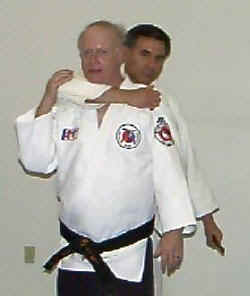 |
Attacker
sets right forearm choke. Your right arm automatically comes up & rests on
his elbow.
|
| |
|
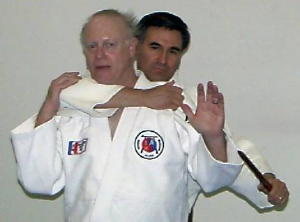 |
Attacker
brings knife up to you with his left hand. Your left hand immediately comes up
to block. You don't know if it's to stab you or threaten you. However, it's
life-threatening & must be dealt with. |
| |
|
 |
Block
his knife hand at the base of his arm with your left forearm, with your hand
open.
|
| |
|
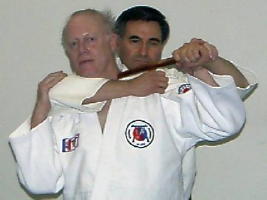 |
Trap
his knife hand with your left hand & keep the knife away from you. You must
keep hold of his arm, at the wrist & keep it bent, so he can't straighten it
out & develop more power for secondary thrusts. Keep hold of his wrist at
ALL costs [to avoid being stabbed].
|
| |
|
 |
Push
his knife hand away as you pivot your right foot back so you can move your body
to his right side. Raise his right elbow up as you turn your head to your left
to get out of the headlock. Even though the knife poses a more serious threat,
the headlock is preventing you from effectively defending against the
knife. You could use a foot stomp or other distracting technique prior to this
move. |
| |
|
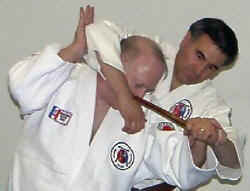 |
Notice
how head slips out of rear forearm choke. Normally a person cannot concentrate
on two things at once. Getting out of the rear forearm choke is possible because
the attacker is concentrating on his left hand. |
| |
|
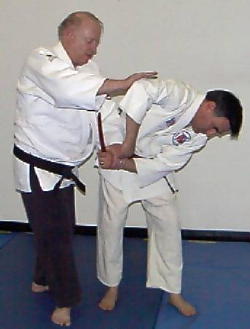 |
Step
your left foot back as you get out of the rear forearm choke. Keep hold of his
left wrist, bringing his knife hand across his body.
|
| |
|
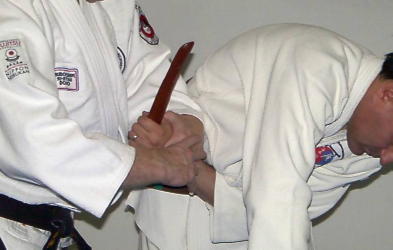 |
Your right hand
grabs hold of his wrist, with your left thumb on the back of his
hand, to set him up for a Te Nage [Hand Throw]. Keep hold of his
wrist with your left hand at this point. |
| |
|
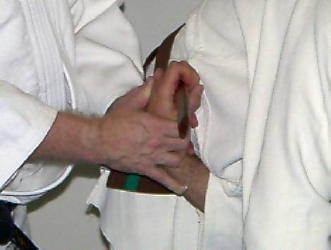 |
Switch
your left hand to apply additional pressure to the back of attacker's left hand,
so that you can bend his wrist, locking his wrist for a hand throw.
|
| |
|
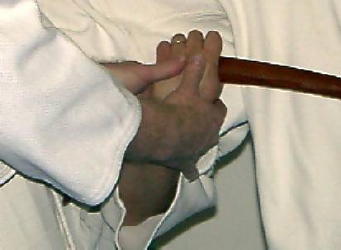 |
This
picture shows the above grip from another angle. Note thumb placement. |
| |
|
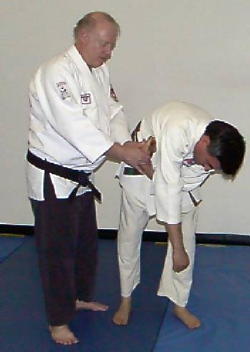 |
From
this point you will execute a standard Te Nage [Hand Throw] by pivoting your
right foot to your right and back in a circle as you continue to apply pressure
to the back of his hand with both of your thumbs. Do not turn his hand. Hold
your arms in the same position relative to your body as you turn your body to
your right to execute the throw.
|
| |
|
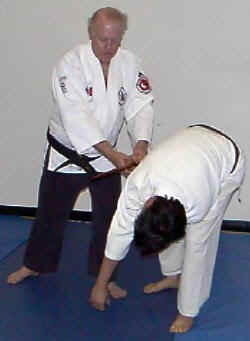 |
Execution
of throw as attacker is about to flip over. Note that his left arm is tight
across the front of his body. Be careful in executing the Te Nage. If done
properly it may break the attacker's wrist if not executed slowly enough so that
you can roll out of it in practice. |
| |
|
 |
Once
the attacker is down you may want to execute a heel strike to his face as a
distraction. If his wrist is broken at this point no further steps are
necessary. I'm moving on because ju-jitsu people never "assume"
anything will work. |
| |
|
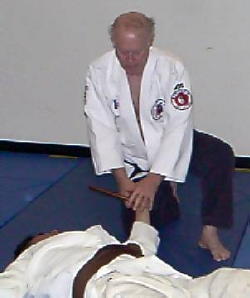 |
Once
the attacker is down drop down & execute a wrist press at this point to
force the attacker to release the knife. If the wrist press is executed quickly
the wrist will break. If his wrist is already broken from the Te Nage you won't
be able to do this. There are also several other submissions that could be done
from this point.
|
| |
|
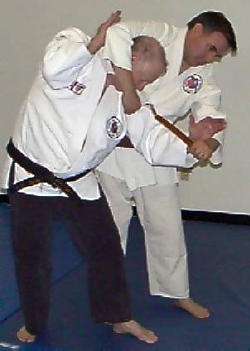 |
My
original plan was to follow the above defense to the point shown in this picture
and then deal exclusively with the attacker's right elbow, using a Mae Heji Maki
[Forward Elbow-roll Takedown], as shown below. However, the technique shown
above, using the Te Nage, was my initial response when actually confronted with
the attack & I still feel it's a better response because the knife hand is
under greater control. On the other hand, the technique that follows could also
be one of many other effective techniques, especially if a distraction strike,
nerve attack, etc., is used somewhere in the initial moves following
blocking the knife, so that you can move quickly into the rear forearm choke
release.
|
| |
|
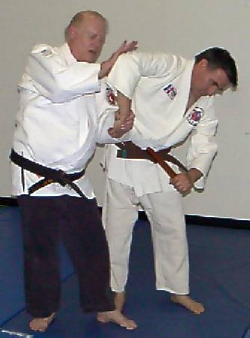 |
Once
you are behind the attacker your left hand grabs his right wrist. Continue to
apply pressure to the underside of his elbow so he can't turn towards you &
attack with his knife hand. |
| |
|
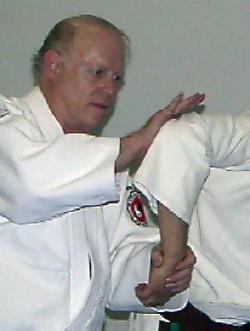 |
Close
up showing grip on his right wrist and placement of your right hand on his
elbow. It's in a Sara [cupped position] so it can rotate and apply continuous
pressure to the attacker's elbow from the underside or back of the elbow. Keep
the sara on the underside of his elbow for most effective leverage.
|
| |
|
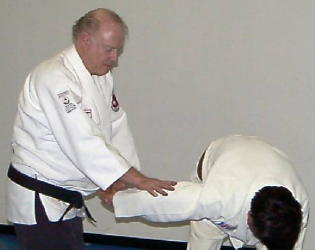 |
Roll
his elbow forward, keeping his arm slightly bent, to bring the attacker forward
. . .
|
| |
|
 |
. . to the ground.
|
| |
|
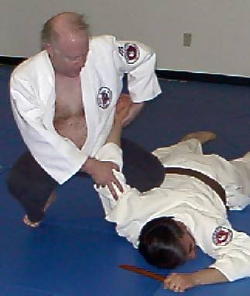 |
Once
the attacker is down, squat down & set your left knee on his back, moving
his right arm into an armlock position against your left hip, resting on
your left thigh. Command attacker to turn his head away from you. You may shid=ft
your wieght onto his right shoulder to encourage this action at this point. It
will actually be more comfortable for the attacker/uke if he turns his head away
as his right shoulder will be flat on the ground. On the other hand, if he
attempts to resist from this position, it will be far more painful as you have
significantly more leverage. |
| |
|
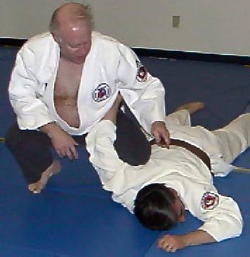 |
Remove
the knife from the attacker's left hand if he still has it. Once his right arm
is locked in this position, you don't need to hold onto it. It's very important
that you stay on your right foot & not go down onto your right knee. If you
do, most of your weight will be on your right knee and not on the attacker. By
staying on your right foot you can shift as much of your weight as necessary to
secure compliance by the attacker. If you execute this submission quickly you
can easily cause quite severe injury to the uke's/attacker's shoulder, so be
careful.
|
| |
|
| |
|
